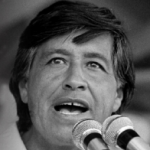
The Impact of Cesar Estrada Chavez on the history of San Jose
By: Karl Soltero
The controversy about Cesar Chavez’s legacy in San Jose brings to mind the question: Who owns History, which is the title of the book written by Professor Eric Foner of Columbia University.
The recent interview by Spotlight San Jose with April Halberstadt of the Santa Clara County History Commission regarding the historical significance of Cesar Chavez makes me wonder who owns my history ?
As a Chicano, I was fortunate and honored to have lived through a period of time known as La Causa (The Cause) during the farm labor strikes led by Cesar in Delano and throughout America and the world. I was raised in Delano and I attended Delano High School with the Chavez children who lived with death threats, name-calling, and harassment during the time when they were supposed to enjoy the high school experience. My parents knew Cesar and his wife Helen since the late 40’s in Delano and I was asked on multiple occasions to do security for Cesar while I attended San Jose State University. I say this because I have experienced the history and heard the oral histories of many heroes and heroines of the Movement who were influenced by the tactics and philosophy of Cesar while he lived in San Jose.
I later attended San Jose State University during the days of the Chicano Social Justice Movement, on campus and in the community where I was privileged to have met many activists who dedicated their lives to social justice for the Chicano/Latino community. As a student of this history I have become friends, seen the documents and heard the oral histories of people who made history yet are now largely neglected and marginalized by historians in San Jose.
While it is true that Cesar left San Jose in the early 60’s to start the United Farmworker’s Union, remember that he and his family began living in San Jose since the 40’s, and because Cesar and his family had to follow the crops, they were often going back and forth between San Jose and Delano, before he moved to Delano to start the union. Remember that San Jose was one of the key grape and lettuce boycott centers during the 60’s and 70’s and that Cesar was always in San Jose.
Remember that Cesar absorbed the teaching of pre-eminent community organizers like Fred Ross and Saul Alinsky, and upon joining the San Jose chapter of the Community Service Organization in the early 50’s, he helped train countless community activists in the art of community organizing. In short, while he may have “moved” to Delano in the early 60’s, his spirit, beliefs, and legacy never left San Jose’s Chicano/Latino community and he remains just as impactful as he was was during those days.
Look at how the CSO members were called “Communist” and disloyal, often followed by police and harassed while doing

SI SE PUEDE!!!!!
voter registration and citizenship drives during the 50’s; how Chicano activists facilitated district elections so that the Chicano/Latino community could have a voice at City Hall. Remember that Ron Gonzales was the first elected mayor of Mexican descent in the modern era and that last year there were five SJ City council members who are of Mexican/Latino ancestry and three are women. Positive changes were made to the educational system after young Chicano students were called “retarded but teachable” by counselors and administrators, police reforms due to documented cases of police brutality were initiated by activists who carried on Cesar’s legacy of non-violence. Health care, a more responsive city and county government, and more educational opportunity at the college level throughout the area resulted in the flowering of the Chicano/Latino professional class. So to say that Cesar was not a part of the history of San Jose after he moved to Delano, exposes one to the fact that perhaps local historians do not care to know about the history of one fourth of the city’s population and how that population helped make Silicon Valley what it is today. In short, Cesar is more alive than ever and his spirit has never left San Jose.
If the so-called “framing” of the history of Cesar Chavez in San Jose is “creating a myth” and stating that his history is “unreliable and misremembered” because it is often oral history as April Halberstadt said , then I submit that cherry-picking historical facts, whether by omission or commission to suit your agenda is simply an attempt to obliterate my history, something that reflects what German philosopher Nietzsche’s called “creative forgetfulness in how the memory of some aspects of the past is predicated on amnesia of others” or in the case of April Halberstadt, claiming to be a “Californio” because she left Missouri and moved to San Jose in the 70’s.
This comment simply reflects a mythologizing and romanticizing of the Spanish colonial and mission periods, and the 49er gold rush that gave opportunists like Thomas Fallon and a governor named Peter Burnett who openly called for whipping black people every two weeks and who offered a bounty for Indian scalps, a place in our local history. Why do we mythologize, glamorize and romanticize these men?
Professor Fomer identifies three views of the historical process: 1) the monumental 2) antiquarian and 3) the judgemental/condemnation view. The first 2 clearly describe this obsession with the mission, hacienda and colonial periods while the last one describes the denigration and marginalization of San Jose’s Chicano/Latino community and its proud history.
May these comments help create an interest in my community’s history in San Jose and make people want to learn more of that rich history. We owe it to each other and we especially owe it to young people.
Karl Soltero.
you can reach Karl by email:karls@ricosolstudios.com
